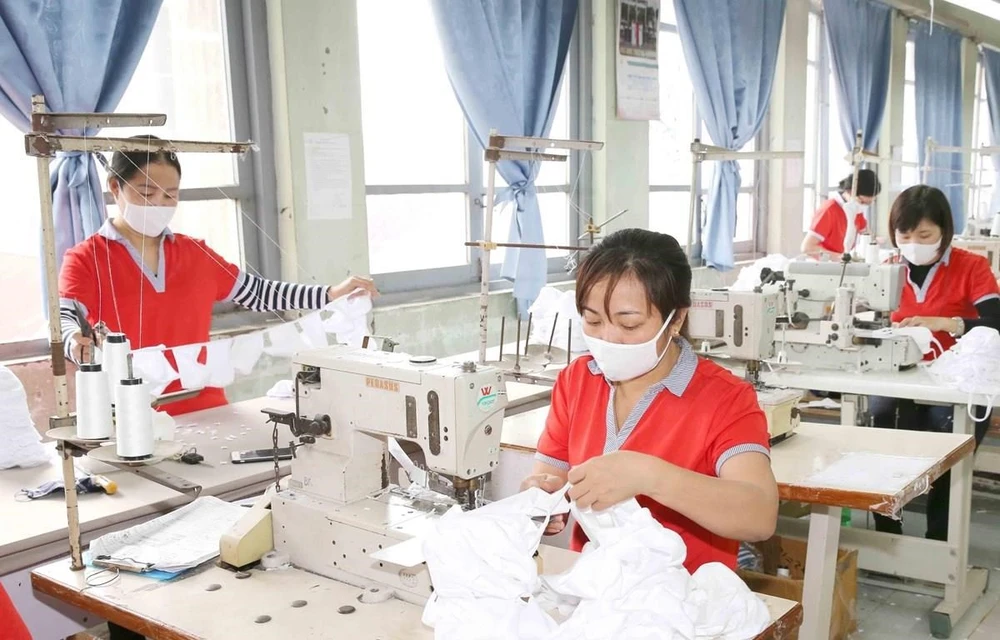
Hanoi (VNA) – Vietnamese policymakers are on the fence about regional minimum wage increase next year, establishing whether it might increase the burden on hard-pressed businesses amid the economic uncertainty caused by COVID-19.
The region’s minimum wage was annually revised by the National Wage Council in July to take into account changes in the cost of living and other economic conditions.
The COVID-19 pandemic is wreaking havoc on the majority of enterprises that are struggling to maintain operations. The number of workers losing jobs rose continuously in the first six months of 2020. The question on whether the minimum wage should be increased, therefore, is still left open.
Manufacturers have been frustrated by declining numbers of orders and a lack of materials. Some 84.8 percent of enterprises said they had encountered financial difficulties due to the impacts of COVID-19. Large and medium-sized firms appear the most vulnerable to the pandemic.
As a result, the majority of firms have been forced to downsize and take measures such as reducing staff, rotating workers, unpaid leave or reducing wages to survive.
According to the Ministry of Labour, Invalids and Social Affairs (MoLISA), employed workers in Vietnam stood at over 52.1 million in the second quarter of 2020, a decrease of 2.2 million from the previous quarter and 2.4 million against the same period last year.
The hardest hit were those working in the areas of textile and garment; footwear and handbags; e-commerce; tourism; hospitality and catering; and transport and logistics.
The period also saw the highest unemployment rate in the last 10 years, at 2.73 percent. The biggest increase was found among low-skilled workers.
Director General of the MoLISA’s Department of Employment Vu Trong Binh said that COVID-19 had taken its toll on close to 31 million people aged over 15 years as of this June, including the laid-off and workers who must take temporary leave or have their work hours and income reduced. Up to 57.3 percent of them suffered from wage cuts.
More than one million among 4.3 million labourers in the industries of textile-garment and footwear-handbags have been made jobless while the rest have worked at only 50 – 60 percent of capacity, causing their incomes to shrink by 40 percent. The pay cuts, as a result, have affected an estimated nearly 3 million families nationwide.
It is likely that the situation will not improve anytime soon. Major firms such as PouYuen Vietnam Company is set to cut down nearly 3,000 employees, while Hue Phong Garment-Textile and Woodworth Wooden also plan to lay off more than 2,000 workhands as their orders halved.
Hoang Quang Phong, vice president of the Vietnam Chamber of Commerce and Industry (VCCI), said enterprises are facing a lot of difficulties and cannot afford to raise the minimum wage.
To facilitate their recovery in such a difficult time, the VCCI proposed not to increase the region-based minimum wage in 2021, he said, adding that it could be viewed as a “refresher” for the enterprises to overcome hardships.
Last month, the National Wage Council put forward two options for the region-based minimum wage next year, with the first keeping the minimum level unchanged to the end of 2021. The second option would see minimum wage increase by 2.5 percent from July 1, 2021, six months later than the usual deadline.
Le Dinh Quang, Deputy Director of the Labour Affairs Department at the Vietnam General Confederation of Labour said the National Wage Council has decided to postpone discussions on the two options to have more time for better evaluation of the country’s socio-economic situation in 2021 and enterprises’ capacity to recover.
Delay in minimum wage raise will enable the firms to better revive, he continued, the decision must take into account the fact that, if firms are operated under capacity or suspended, they cannot afford a wage hike.
The regional minimum wage is the lowest amount paid to an employee performing the simplest job in normal working conditions and carrying out their job as required.
Other allowances, supplemental pay, subsidies or bonuses decided by enterprises are paid according to terms and conditions of labour contracts, collective labour agreements or statutes of enterprises.
The minimum monthly wage for workers in Region one, which covers Hanoi and HCM City's urban areas, is currently 4.42 million VND (191.39 USD), Region two – covering Hanoi and HCM City's rural areas, along with major urban areas like Can Tho, Da Nang and Hai Phong – is 3.92 million VND
The level in Region three, or provincial cities and the districts of Bac Ninh, Bac Giang and Hai Duong provinces, is 3.43 million VND a month, and 3.07 million VND for Region four, or the rest of the country./.























